Panasonic Lumix DMC-TZ5 Features
The Panasonic Lumix TZ5′s standout features are its lens, LCD screen, HD video output and “Intelligent Auto” exposure mode.
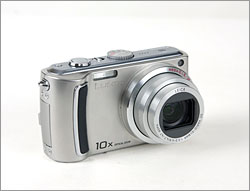 |
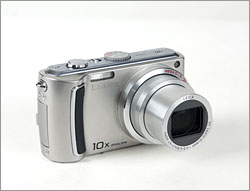 |
|
| Panasonic Lumix DMC-TZ5 10x 28-200mm wide-angle Leica lens | ||
![]()
First, the lens: There are few cameras this small with a wider-angle or longer-length lens. The TZ5′s 28mm wide-angle will allow you to capture more of a scene, whether it’s a faraway city skyline or an arm’s-length shot of a kid’s face. At the other end of the focal length, the 10x zoom (equivalent to 280mm) will let you frame the architectural details of one of the buildings in that city skyline or catch the kid’s facial expression from across a playing field. A handy “Easy Zoom” button switches between the two focal lengths in about two seconds. And Panasonic’s Mega O.I.S optical images stabilization helps keep things sharp by compensating for camera shake in low light or at the full 280mm telephoto focal length.
The 3-inch LCD screen on the back of the TZ5 is big, colorful and sharp. It’s also relatively easy to see in bright sunlight and from many angles, unlike some cameras.
The camera can record video in 4:3 or 16:9 aspect ratios, up to an impressive 1280 x 720 HD resolution at 30 frames per second. This means you can share your videos everywhere from YouTube to the HDTV in your living room. (An optional cable is required to connect the camera directly to your HDTV.) Another cool feature is that you can zoom in and out while shooting video.
“Intelligent Auto” exposure mode truly lives up to its name. Unlike regular Auto mode (which this camera does have), Intelligent Auto mode recognizes the type of scene – landscape, portrait, macro, night scenery, or night scenery with portrait – and focuses and exposes accordingly. It’s impressive to watch, for example, the Macro icon blink on or the Face Detection brackets kick in. Exposure compensation is quite good, too. While not foolproof, Intelligent Auto mode is a lazy (or beginning) photographer’s dream.
More motivated photographers can use regular Auto mode to control settings such as focus, ISO and white balance. There are also 23 scene modes, with settings customized for everything from Portrait, Landscape and Sports to Pet, Starry Sky and Aerial. Two dial settings, SCN 1 and SCN 2, let you easily pre-select a scene mode. This is a convenient way to switch back and forth from, say, Night Portrait to Night Scenery.
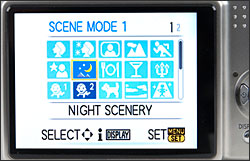 |
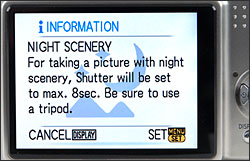 |
|
| Panasonic Lumix DMC-TZ5 Scene Mode menu and “Night Scenery” mode description | ||
![]()
All Panasonic Lumix DMC-TZ5 Camera Menus >>
When selecting scene modes, each is illustrated by a tiny, animated graphic (e.g., a running stick figure for Sports mode). I found this annoying at first, but it’s grown on me. Pressing the Display button while a scene mode is selected will provide a brief explanation of its settings. I personally am underwhelmed by the ability to pre-record name and age in not one but two Baby scene modes, but I am sure there are parents out there who will find this feature useful.
Menu and Quick Menu settings are easy to access and reasonably intuitive, especially if you take a little time to study the manual.
Travelers – especially those who like to travel as light as possible — may be intrigued by the special Clipboard mode, which lets you photograph documents such as maps and itineraries and store them separately from other images on the camera.
Panasonic Lumix DMC-TZ5 Design
There may be some who will think this camera looks boring or old-fashioned. Not me. I think it has a very stylish, retro appearance. It makes me think of James Bond, circa 1965. The no-frills metal body comes in black, silver or blue, with a big Leica lens and modest lettering dominating the camera face. The controls on the top and rear of the camera are simple and straightforward – an on/off switch; a dial for exposure settings; a button/lever combo for focus, shutter and zoom; another switch for shooting and playback; and a four-way navigator and three tiny buttons for all other controls.
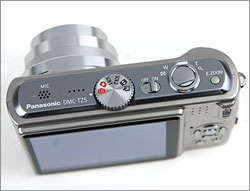 |
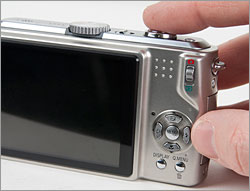 |
|
| Panasonic Lumix DMC-TZ5 Controls and LCD | ||
![]()
The TZ5 measures 2.33 inches tall by 4.07 wide by 1.44 deep and weighs just under half a pound. This makes it a little too big to officially qualify as pocket-sized; there are plenty of smaller point-and-shoots out there. That said, this camera will fit into most pockets, although it might be a bit bulky in your pants or shirt pocket. I find its size comparable to my Palm Treo smartphone and 40GB iPod, and it fits fine in my smallish shoulder purse.
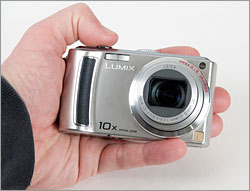 The build looks and feels solid. Heftier than some of the point-and-shoots I’ve tried, yes — but not so you’d notice. I can’t testify to the TZ5′s ability to hold up under rough handling and weather conditions, but it doesn’t look or feel the slightest bit flimsy. It’s a comfortable camera to hold and seems ergonomically well-designed. I also greatly appreciate the TZ5′s small, cordless battery charger.
The build looks and feels solid. Heftier than some of the point-and-shoots I’ve tried, yes — but not so you’d notice. I can’t testify to the TZ5′s ability to hold up under rough handling and weather conditions, but it doesn’t look or feel the slightest bit flimsy. It’s a comfortable camera to hold and seems ergonomically well-designed. I also greatly appreciate the TZ5′s small, cordless battery charger.
My one and only complaint with the external design is that the exposure mode dial is too easily moved. It often comes out of my purse with the dial in a different position from where I left it, or in between positions altogether. I’ve learned to always check the dial setting before I start taking pictures — a mild annoyance.
next page – Panasonic Lumix DMC-TZ5 Camera Experience >>


Leave a Reply